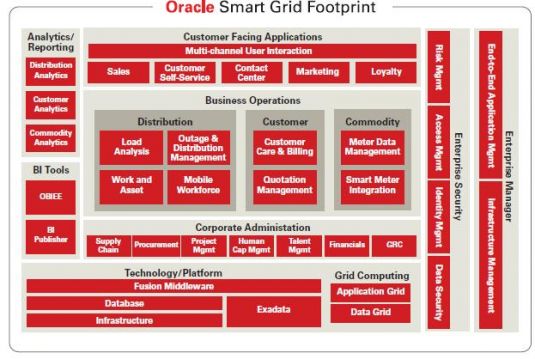Oracle is one of the heavyweights of big data, and it’s also big in utility software. That includes its back-office heft in customer information systems, workforce management, and enterprise resource management, as well as the platforms, such as meter data management and distribution grid management, that reach into the grid itself.
All of this makes Oracle a serious contender in smart grid data analytics, where it’s striving against IT competitors such as IBM, SAS, Teradata, EMC, SAP, and others in a race to define this still-nascent field. All are promising to transform the way utilities manage and utilize the floods of data coming from all their new smart meters, line sensors, substation control systems and other grid technology, as well as turning as-yet untapped sources of customer, workforce and business process data into new forms of insight and value.
But just how are these opportunities being realized in the real world? At this week’s OpenWorld conference in San Francisco, Oracle unveiled its latest set of utility-specific data analytics products -- not just in terms of which utility problems it’s striving to help solve, but also in terms of the forms in which it is packaging them and delivering them to utilities at different stages of the “big data” evolution.
Those range from custom-designed infrastructures aimed at big utilities with sophisticated IT departments, to prepackaged operational dashboards that integrate applications from Oracle’s long list of business software products, as well as third-party products, Dan Byrnes, GVP of product management and development, said during a Wednesday presentation.
It also includes Oracle’s “Advanced Analytics Cloud Service,” or, in other words, the expanding set of cloud-based offerings that Oracle is building onto DataRaker, the metering analytics firm it bought last year, he said. Since then, the two companies have extended those capabilities to include theft detection, outage restoration, and mobile workforce management for utility field workers, as well as making their first forays into load balancing, line loss, volt/VAR management, and predictive modeling for grid operators.
As for integrating the masses of legacy utility data into the latest big data platforms, Oracle announced that its nine-month partnership with Xtensible Solutions has yielded what Byrnes called Oracle’s Utilities Data Model -- a first glimpse at how it’s turning utility-specific Common Information Model (CIM) data into a standard format to be used by its prepackaged and cloud-based analytics.

Greentech Media’s Soft Grid 2013 conference, taking place next week in San Francisco, will give utilities a chance to learn more about Oracle’s new offerings, as well as those from its competitors and sometime partners. In the meantime, here’s a quick breakdown of what Oracle announced this week.
1) Turning DataRaker Into Broader Cloud-Based Analytics. Back in August, we described how Sausalito, Calif.-based DataRaker, founded in 2007, has built a cloud-based analytics platform aimed at a whole range of meter-to-insight functions. That included the company’s claim that it differs from traditional MDM systems, which were built first for “meter-to-cash” billing and have since expanded to analytics, in that it has always put broader analytics first.
At that time, DataRaker had 18 million meters under its purview, out of a total of 24 million under contract, and was working with utilities including PPL, PECO, Kansas City Power & Light, and Puget Sound Energy to perform functions including energy diversion and theft detection, customer service enhancement, distribution optimization planning and AMI deployment support.
In December, Oracle bought DataRaker for an undisclosed sum, and quickly started touting how it would beef up Oracle’s existing line of analytic capabilities. Those included an initial focus on non-responsive meter analysis and revenue protection (i.e., energy theft and loss detection), but were quickly expanding to transformer monitoring and preventative maintenance, distribution line volt/VAR management, and other such grid-facing tasks, according to a conversation I had with Linda Jackman, group vice president of industry strategy for Oracle Utilities, at January’s Distributech conference in San Diego. (Jackman will be speaking at next week’s Soft Grid conference as well.)
At Wednesday’s presentation, Byrnes gave an update on that progress, including the fact that the DataRaker system is now collecting and analyzing data from about 22 million meters, most of them delivering data in fifteen-minute intervals. That makes it “the only high-volume, cloud-based offering that can scale in a proven, 'been there, done that' model,” he said -- a claim that’s almost certain to be challenged in short order.
He also demonstrated how one utility is merging the DataRaker meter analysis functions with a mobile workforce platform, which allows utility personnel to diagnose and fix meters in the field and upload the results back into Oracle’s cloud platform. “That allows us to get intuitive, and smarter, in a closed-loop fashion, as the analytics get refined," he said.
While DataRaker is now limited to North America, Oracle intends to push its new cloud-based analytics to a global audience in 2014, as well as adding more workforce management capabilities in that timeframe, he added. As for more advanced features, Byrnes targeted 2015 for cloud service integration of grid operations, but also noted that Oracle is already working on those types of projects.
In particular, he said that one “major Southeastern” U.S. utility was applying the new cloud-based platform for analyzing distribution line losses, load balancing, and volt/VAR optimization, in a move toward the holy grail of “predictive modeling” of distribution circuits and assets. (While Byrnes didn’t name the utility, it should be noted that big Florida utility FPL has recently shared with Greentech Media some of the advanced analytics it’s deploying on top of its region-wide AMI deployment -- and DataRaker, and now Oracle, are partners in that effort.)
2) Normalizing Legacy Utility CIM Data for the Next Generation. When it comes to standardizing data to allow it to be shared from system to system or utility to utility, one of the broadest sets of definitions out there is the IEC’s Common Information Model, or CIM.
But as an “abstract information model that provides data understanding through the identification of the relationships and associations of the data within a utility enterprise,” the CIM standard leaves much to be desired in terms of how well it serves to support specific, point-to-point data interoperability. That’s led to various attempts to define CIM’s terms more specifically, including the MultiSpeak effort underway at many U.S. utilities.
On Wednesday, Oracle and partner Xtensible Solutions, a subsidiary of Doble Engineering, revealed their own take on the CIM integration challenge, via their new Oracle Utility Data Model. Xtensible CTO Joe Zhou described it as the first step in turning “data marks that don’t talk to each other and don’t have the same conformed dimensions into an infrastructure and business dictionary, where you can continue to grow.”
“We’ve built a very comprehensive and robust data model for the utility industry,” he said, using Xtensible’s expertise in taking lots of disparate data models and turning them into an integrated system. From there, the partners have created what he called “an enterprise data warehouse solution stack,” to tie systems where CIM is the lingua franca, such as utility operations, into the existing wealth of business enterprise systems that Oracle and all its competitors offer.
While Zhou did list a set of functions that the Oracle Utility Data Model is striving to perform on that front, he also stressed that it’s not yet production-ready. Rather, it’s meant to serve as a showcase of capabilities to come, he said.
It’s also a pretty clear stake in the ground for Oracle to establish itself as the integrator-of-record for CIM-to-business analytics. As Zhou said, “This is how the CIM is physicalized -- this is now an Oracle product.” No doubt companies working on systems aiming at utility-wide data normalization, such as Teradata’s Utilities Logical Data Model or IBM’s Solution Architecture for Energy and Utilities Framework, will be taking note.
3) Oracle’s Big Iron, Working With Others. Oracle CEO Larry Ellison made a big splash on Sunday by announcing the latest in the company’s attempts to beat out longstanding rival SAP in the field of in-memory (i.e., super-fast) data analytics. We’re certainly not going to delve into that bitter feud in this article, or try to parse out the technically dense competitive details that underlie the back-and-forth between Oracle, SAP, IBM and other contenders over whose big data technology is better.
Let it suffice to say that Oracle has some big iron that it wants to sell to its data analytics customers, including utilities. Those include Oracle’s Exadata database appliance, its Exalytics in-memory machine, and other such computing hardware that can serve as the foundation of major analytics efforts from big investor-owned utilities ready to take on the challenge.
At the same time, Oracle is also working to allow its less IT-involved utility customers to make use of the company’s capabilities, both with its own software platforms and with others, Byrnes said. That includes a set of “prepackaged operational dashboards,” a collection of some 250 sets of standardized reports that utilities will be able to run using a variety of data sources that Oracle’s collecting into various data libraries.
Once again, the idea here is to bridge the gaps between traditionally siloed utility departments like customer billing, workforce dispatch, asset management and the like. Oracle plans to release new dashboards every six to nine months, starting with a “much deeper” dive into customer care and billing, credit and collections, and other revenue-centered reporting capabilities.
As for integrating Oracle offerings into other systems, Byrnes promised that its new prepackaged solutions set will be able to integrate with others’ enterprise reporting software, as well as give customers the ability to build new applications based on its underlying data libraries. Of course, Oracle is not well known for playing well with others -- but perhaps its recent spate of partnerships with competitors it once spurned may be changing that view.



